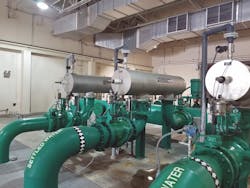About the author:
Robin Brooks is content provider for Tekleen Automatic Filters Inc. Brooks can be reached at [email protected].
The City of Missouri City, TX near Houston currently is using three Tekleen filters at their regional surface treatment plant that provides drinking water. Raw water is pulled into the system from the Briscoe Canal which is sourced by the Brazos River.
The plant was built in 2010. The first two Tekleen filters are original to the plant. The Tekleen filters were selected by the plant engineering team, Enprotec/Hibbs & Todd Inc. from Abilene TX. Because the installation has been very successful, the city added a third Tekleen filter in 2017, due to its growing need to provide potable water to the area. A fourth filter is currently in process.
The city has 3 planned phases to meet present and future water needs. It is currently in Phase 1, which can treat up to 10 million gallons (MGD) per day. Phase 2 will treat 20 MGD, and Phase 3 will treat 33.5 MGD. Phase 2 will require an additional Tekleen filter.
According to Contract Plant Operations Manager Leonard Hansen, the units have been working very well. Filter cleaning is all done automatically inside the Tekleen unit, and the rinse water from the self-cleaning process is sent back to the raw water reservoir.
Self-cleaning takes place automatically approximately every 45 minutes. If needed, the filter self-cleaning cycle can be initiated manually by plant management by triggering the electronic controller.
The filter units involved are Tekleen model LPF-14-LP which is a low pressure model that includes the electronic controller that senses system pressure and initiates the self-cleaning cycle when a 7 psi differential pressure indicates it is needed. The Tekleen filter units were assembled with the filter body style and components most suited to this application. The filter units each use a 300µ screen designed for 5,000 gal. per minute.
Because they are self-cleaning, and it is an automatic process, there is no labor or downtime required for regular filter cleaning. The filters are made from stainless steel, and consequently there is no risk of deterioration. This means longer equipment life, and no contamination into the water from rust or plastic wear-off.
By filtering the water and preventing scale formation, the Tekleen filters protect the microfiltration system that produces drinking-quality water for the district. The microfiltration membranes used in the Missouri City installation are manufactured by the PALL Corporation.
Understanding the Flow
The raw water comes from the Briscoe Canal system owned and operated by Gulf Coast Water Authority. From there it flows into a reservoir that can hold up to 100 million gallons. It is pumped to the station where the Tekleen filters provide one of the last stages of removing particles and other debris.
From there it flows into a reservoir that can hold up to 100 million gallons. It is pumped to the station where the filters provide one of the last stages of removing particles and other debris. The filtered water is then sent to the microfiltration system. Because the water is already cleaned down to 300µ at this point, the microfiltration membranes are well protected against potential damage and are provided with a very steady and predictable flow, important to microfiltration functioning.
A year ago, Tekleen was able to ship a replacement valve to Mark Daurity at the Missouri City plant over a weekend, which minimized their downtime. Customer service is one of the keys to Tekleen’s success. If any part goes bad in a Tekleen Installation, such as parts that might get stressed and break because of operating conditions, Tekleen can generally ship a replacement part the same day. Tekleen has access to thousands of component parts and associated installation parts around the globe.
Planning the Facility
The water quality goal was to provide potable water to meet all current and anticipated future standards in 3 stages of plant development. Raw water is stored in amounts that protect against quality upsets and supply interruptions from the source water, which is the Brazos River. The system uses settling and other preliminary techniques before the water gets to the Tekleen filters. After the water leaves the Tekleen filters, it is sent to the microfiltration system where final filtering is done. The final output is treated with disinfectants. The drinking quality water is then sent to ground storage in Stage 1 of this plan. From there it is sent to the various municipal distribution points. The residual solids from settling and filtering are sent to a landfill for disposal.
Prefilter Protection
Microfiltration membranes are at the end of the filtering line. They are an expensive part of producing drinking water. Microfiltration requires a steady stream of input at a predictable flow rate in order to function optimally. The membranes are susceptible to damage and obstruction. Water going to microfiltration membranes ideally should be reliably filtered and provide a good, steady flow rate. Tekleen filters do this, providing protection against what is known as Membrane Fouling.
